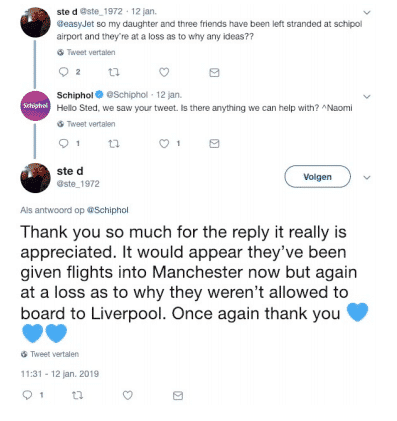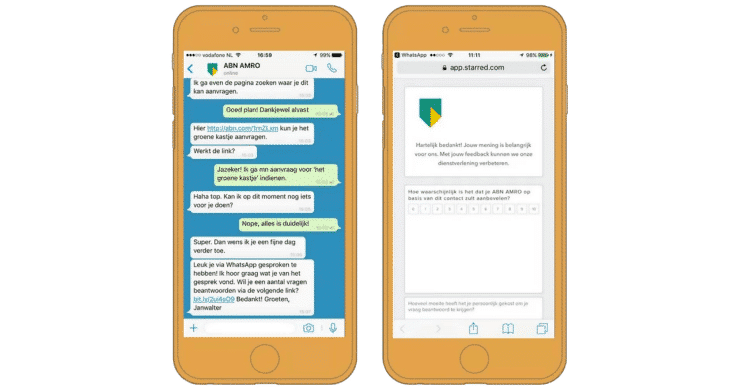5 steps to optimise online customer service

Many organisations purely see webcare as a form of customer service: a new way of answering complaints and questions for customers online, rather than through email or telephone. Of course, answering questions and complaints is the core of webcare, however, the customer engagement team can have a much larger function. Webcare functions as the eyes and ears of your organisation. It is not only about responding quickly and adequately to stakeholders via online channels; it is about engagement, spokesmanship, marketing and sales. Customer engagement should concern all online channels through which consumers express their opinions.
Webcare is becoming an integral part of online customer engagement. Webcare has grown up, however, knowledge comes with the years. For example, we have seen that a broad application of webcare is still in beginning stages in many organisations. Far too often webcare is simply used as a tool to refer to traditional customer contact channels. It is important for organisations to integrate webcare and client engagement on a strategic level.
Step 1. Choose for optimal accessibility
The core of webcare can be seen as the dialogue between customers and organisations. A direct message via Twitter, a post on Facebook, live chat or a WhatsApp message are all part of the daily activities of webcare teams. However, have you thought about other online channels on which customers talk about your brand or organisation? Such as review sites, forums or news items.
Customers will always choose to communicate through the online channel that best suits their situation at that time. This could depend on time or location, but also on the need for specific information. It is important for organisations to have a clear view on the media landscape around their business. Actively monitor social media, but do not forget about forums or review sites. Taking another step into monitoring would be via print media, radio and TV, this will provide you with a full overview of opinions, questions and complaints.
Having an omnichannel strategy for webcare does not have to mean that you are accessible through all these channels, it means that you make optimal use of the unique characteristics of each channel. For example, messaging channels make customer engagement accessible and low input and live chat is is fast and personal. In short, adjust your presence in online channels to the wishes of your customers and ensure optimal accessibility for customer engagement.
“Webcare fulfills the essential role it should have: to boos changes throughout the organisation. Affecting sales, marketing, product development, strategy and policies of every organisation.” – ROB SPEEKENBRINK, CO-FOUNDER NOSCURA
Step 2. Take advantage of the possibilities through proactive webcare
Customers expect to be helped quickly and effectively through the channels in which they search contact. Organisations tend to miss out on opportunities by only responding to messages directed to their own accounts.
The added value of proactive services lies in providing information or a helping hand without customers or prospects having initiated the contact. By doing so, organisations can quickly act on a problem before it escalates and can potentially turn a negative sentiment into a positive customer experience. This positive experience will reinforce the long-term relationship with customers. Additionally, it will offer the ability to connect with new customers. A positive client experience with webcare is often shared online and can reach a large number of potential customers through online channels.
How proactive webcare supports Schiphol’s company vision
Of all conversations that take place around Schiphol’s social media channels, more than a quarter is proactive. Proactive webcare is an integral part of Schiphol’s vision to be “Europe’s Preferred Digital Airport”. In their Customer Contact Center, a team of Social Media Specialists regularly monitor and and answer posts regarding Schiphol through the Spotler Engage tool. In addition to answering customer questions, Schiphol aims to provide as many passengers as possible with a warm welcome through proactive, personal and relevant conversations. This approach has shown to be successful, the number of social media interactions has increased by over 250%, on a yearly base more than 25 million people have been reached.

Step 3. Report, analyze and signal points of improvement
When making use of reactive or proactive webcare, reporting is necessary as the organisation will need to monitor whether agreed KPIs are being achieved. In addition to this, the analysis will provide insights into the effectiveness of the customer communication and customer feedback in a structural manner.
The customer engagement is becoming increasingly important to increase organic reach, whereas the number of followers on your account is becoming less important. Customer interaction is the core for marketing and services, with a fast response being an important standard for many organisations.
Therefore it is more interesting to measure how well you provide online customer service, as good service is the new marketing. The examples below can provide valuable insights for your organization:
- Number of leads via social media.
- Answered questions or resolved complaints.
- Open,completed and closed cases.
- Response rate per employee.
- Positive feedback / negative feedback.
- Sentiment about your product or service.
- Volume ratio per channel.
- New ideas for product development.
- Online activity of your competitors.
- Activity inside or outside service level.
Optimize through on data
Use real-time insights to guide the webcare team where necessary. When service levels threaten to be exceeded, you can intervene and try to find the cause through provided data.
This does not end with measuring the service level. Reporting on the quality of webcare and continuously working towards improvement also provides other insights. Forecasting call traffic to optimise the occupancy of your customer contact center is an example of this. It is also possible to make predictions based on online data, for example to determine the required staffing of the webcare team.
It is also possible to evaluate the quality of service per employee based on evaluating answers on substantive knowledge of products or service, formulation of the answer and the extent to which the employee is empathic towards the customer. Employees who use words such as annoying, unfortunate or bad in their answers have a negative impact on the sentiment. Coaching your employees on positive language usage could be a solution.

Gather customer feedback with webcare
The increasing impact of webcare has also created a growing desire to know how customers actually experience the contact through these online channels. This customer feedback can be a goldmine for points of improvement for your organisation, products or services.
Large organisations receive a lot of unsolicited feedback via social media. After all, they are talked about online. These messages contain both negative and positive sentiments. Because there is no active request for feedback, you as an organisation have no control over the subject, type and frequency.
Combining these two types of customer feedback to gain insights into structural points of improvement for the organisation. In addition, it is important to compare different contact channels (telephone, mail, social, chat etc.) for one integrated customer view. If you want to collect customer feedback through online channels, good preparation is necessary.
Make use of the tips below to collect customer feedback and reviews successfully through webcare:
- Use a clear question: directly be clear to the recipient about what you expect from them. Also make sure that you only collect feedback to which you can link your actions.
- The more reviews, the more credible you are: Make sure that you have collected enough reviews to create a credible image of your organization. This makes the quality of your organisation come across more strongly.
- Use reviews to influence your ranking: reviews can not only be used internally, but also externally to improve your position within Google.
- Involve the webcare agents in the process: Inform them that you are asking for feedback on the service they provide. Openness and transparency help to gain the best result!
- Don’t be afraid of negative reviews: These give you the opportunity to solve the problem and show the outside world that you take the feedback given seriously.
By implementing a tool you can collect customer feedback and measure customer satisfaction automatically. Reports on webcare activity can be expanded in this way with metrics such as NPS (Net Promoter Score).
Step 4. Determine the added value of chatbots
We already know that chatbots are gaining popularity. The adoption by the business community, often fuelled by the drive for saving costs and increasing efficiency, is another motive for the growing popularity. One thing is certain, chatbots are here to stay!
Chatbots come in many shapes and sizes. Think of smart chatbots, integrated in webcare tools or in a supporting form of information provision for customer service employees. However, bots can also fulfil another function, such as that of work planner or business analyst.
It is important to first determine what the purpose of a chatbot is, before you start with the development and implementation within your webcare process. You should determine if and how a chatbot will add value to your organization. The use of supporting or automated webcareis extremely suitable for organisations that often receive the same questions or requests. In addition, a chatbot can provide quick and accurate information on services and products with low human involvement.
Besides determining the goal and added value, you can use the steps below to develop a chatbot:
- Conduct a feasibility analysis scan that provides insights into on which application a chatbot will be the most successful within your processes.
- Create dialogues: create a list of questions and answers that can would be answered by the chatbot.
- Chatbot training: teach the chatbot desired responses to the provided example questions.
- Link with external systems: based on the business rules, a chatbot knows exactly which system to consult and when.
- Test the chatbot: test its operation and determine what further training is needed. This also gives you an indication of the effectiveness of the chatbot.
“The goal of a conversational chatbot could be to make the service process more efficient, to decrease costs and increase customer satisfaction.” – FRANK SMIT, CHIEF INNOVATION OFFICER AT Spotler Engage
Step 5. Define the strategy for webcare
A clear strategy is needed for webcare in order to optimally make used of the points discussed previously. An important aspect of a webcare strategy is for unambiguous communication. In this policy you keep track of; which tone of voice you use, how you deal with complaints and compliments and to what extent something should add to the quality of webcare.
A tone of voice that connects organisation and customer
Answering similar questions with different answers creates confusion, especially on public messages in which everyone can read along. Agreements need to be made internally about the desired tone of voice and when, where and how to (or not to) respond to messages. Different strategies should be created for responding for different types of situations, to make sure the team is not confronted with any surprises.
You should adjust your tone of voice for positive, neutral and negative situations. A humorous and relaxed answer can work well in a positive situation, but would be inappropriate in a negative situation. Marcel Vergonet recommends that the tone of voice should not only be developed by the marketing or communications department:
“Involve customer service staff in the development of the tone of voice. This is how you create personal responsibility and internal support.” – MARCEL VERGONET, CLIENT CONSULTANT AT Spotler Engage
Think about how you communicate during:
- Crisis situations;
- Regular questions;
- Complaints;
- Factual inaccuracies;
- Compliments.
A good rule of thumb is to always use a ‘conversational human voice’, or human communication from your company accounts. The more customers feel that they are communicating with a person, the more successful webcare will be.
“Adapting to the informal tone that consumers also use in their tweets and comments creates the illusion of face-to-face communication and can generate feelings of empathy, familiarity and equality.” – LOTTE WILLEMSEN, LECTOR (PROFESSOR IN APPLIED SCIENCES) UNIVERSITY OF APPLIED SCIENCES UTRECHT
Every compliment is an opportunity!
In webcare another focus point can be found in damage control. Complaints and critical questions are handled faster and more carefully than when a customer gives a compliment. After all, the customer is already satisfied.. right? Yet the power of a compliment should not be underestimated.
We often tend to respond with ‘Thanks, nice to hear!’ or ‘We will pass on the compliment’, while these customers are (potential) ambassadors of your brand. These people stay longer, buy more and will positively recommend your product or service to people around them. So it pays off to take a critical look at how an organisation deals with compliments.
Reward a compliment with a fun, witty or personal reaction. In turn this provides the giver of the compliment with a good feeling, lowers the threshold to get back in touch and immediately makes the engagement more personal.
“It is important to put the interests of the customer first. The customer has come to you via a public platform, but handling a complaint or question carefully should always be chosen above being funny.” – MARCEL VERGONET, CLIENT CONSULTANT AT Spotler Engage
The role of humour in webcare
We are seeing it more often; webcare teams joking while handling a question or complaint. These funny conversations are regularly highlighted on sites like The Best Social Media or Reddit. But how far can you go as a webcare team? What are the do’s and don’ts of making jokes while handling questions, complaints, comments and compliments?
The use of humour within a webcare team remains to be something that will have to be felt. In general, our advice is to be careful when responding to a complaint with humour. It is important to help the customers with their problem first.

Whether it’s the software solution for efficient webcare, reporting on KPIs or determining a policy for webcare. Spotler Engage is the partner for you! Spotler Engage helps organisations to successfully make use of media monitoring and webcare. Our user-friendly tools support our customers with online and offline media monitoring, webcare, messaging, social analytics and content publishing.
Since 2009, all relevant messages have been collected from well-known social media platforms and millions of (inter) national blogs, forums and news sources. Supplemented with innovative solutions for radio, TV and print monitoring, you will never miss a relevant message again. In addition, our team of enthusiastic service agents and consultants are ready to advise our customers daily on the optimal use of Spotler Engage!
Spotler Engage offers award-winning solutions and services for reputation management, action-oriented insights from data, customer experience, chatbots and artificial intelligence. We make innovative technology accessible and offer user-friendly tools as well as extensive services such as research and data analysis, strategy development and training.
Do you have questions after reading this white paper about the optimal use of webcare?
Then we’d be happy to help you achieve this. Contact us via (0)85 210 50 60 or contact-engage@spotler.com.